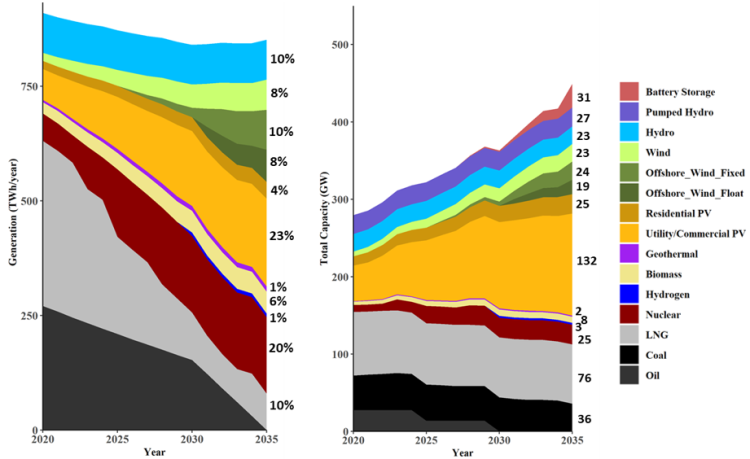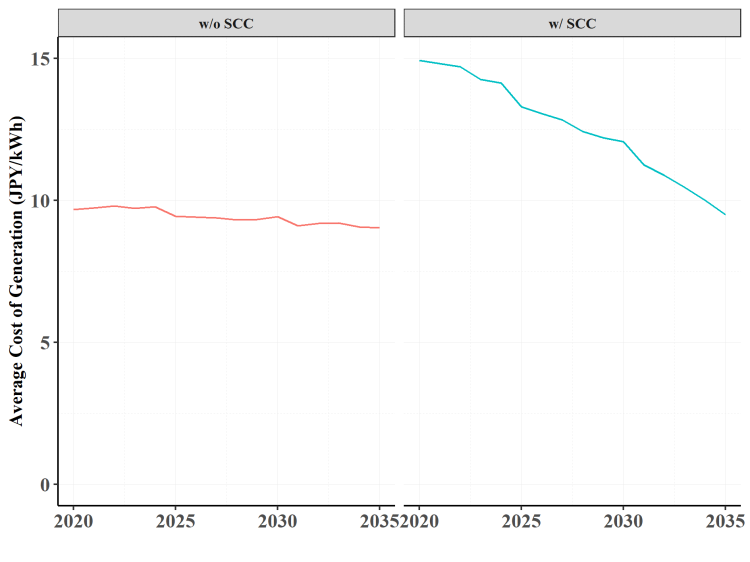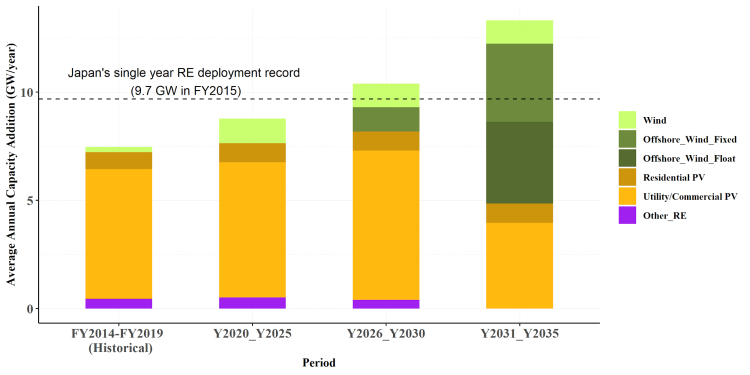Japan faces a significant energy security risk as it imports nearly all the fuel used in its power sector, with clean electricity accounting for only 24% of the total in 2019. A new Lawrence Berkeley National Laboratory study shows that, due to the decreasing costs of solar, wind (especially offshore), and battery technology, Japan can achieve a 90% clean electricity system by 2035. This would also result in a 6% reduction in electricity costs, nearly eliminate dependence on imported liquefied natural gas and coal, and dramatically reduce power sector emissions. Furthermore, the study finds that Japan's power grid will remain dependable without needing new gas capacity or coal generation. Complementary policies to support an ambitious 90% clean electricity target by 2035 are required to take advantage of these significant economic, environmental, and energy security benefits. A complementary Climate Integrate report (link is external) provides policy recommendations to support a 90% clean grid by 2035.
The followings are key takeaways from the report:
Strong Policies are Required to Achieve a 90% Clean Grid by 2035
The 90% Clean Grid (Clean Energy Scenario) assumes strong policies drive 90% clean electricity by 2035. Institutional, market, and regulatory changes are needed to facilitate the rapid transformation to a 90% clean power sector in Japan.
Japan's 90% Clean Grid Is Dependable without Coal Generation or New Natural Gas Plants
There has been longstanding debate about whether Japan could dependably operate electricity systems with high shares of variable RE (VRE). The study finds that a 90% clean energy grid that features accelerated solar and wind capacity additions, new battery storage, and new interregional transmission infrastructure can be combined with a small percentage of the existing fossil fuel-based generation capacity to meet Japan's electricity demand reliably, while maintaining planning reserve margin and operating reserves.

Figure 1. Generation Energy Mix and Total Installed Capacity between 2020 and 2035, Base Fuel Price Scenario
Electricity Costs from a 90% Clean Grid are Lower than Today's Costs
In the Clean Energy Scenario, RE coupled with enhanced energy storage and interregional transmission lines make it possible to displace a significant amount of generation from existing coal and natural gas plants, while maintaining grid reliability and decreasing wholesale electricity costs. The incremental cost of developing new solar and wind plants, battery storage, and transmission infrastructure in the Clean Energy Scenario is smaller than the fossil fuel, operation and maintenance (O&M), and other fixed costs found in running today's typical fossil fuel plants (Figure 2).

Figure 2. Wholesale Electricity Costs with and without Social Costs of Carbon (SCC) for the Clean Energy Scenario, between 2020 and 2035 (2020 JPY)
85% Reduced Fossil Fuel Imports and a 90% Clean Energy Grid Can Significantly Bolster Japan's Energy Security
Under the Clean Energy scenario, imported coal and natural gas costs would decrease by 85%, from 3.9 trillion Yen (JPY) in 2020 to 0.59 trillion JPY in 2035. By maximizing Japan's use of domestic renewable resources, it would significantly decrease the nation's heavy dependence on imported fossil fuels. In turn, this would bolster Japan's energy security, insulating consumers and the economy from skyrocketing international fossil fuel prices.
Scaling-Up Renewables to Achieve the 90% Clean Energy Grid Is Feasible
Under the 90% Clean Energy Scenario, the combined capacity of all RE sources rise from 90 GW in 2020 to 188 GW in 2030 and 254 GW in 2035 (Figure ES1). In particular, accelerated wind and solar capacity growth makes the 90% clean energy grid feasible. On average, an additional 10 GW of RE need to be brought on-line each year (from 2020 to 2035). This annual increase, comparable to Japan's single-year renewable buildout record of 9.7 GW (FY 2015), is challenging but feasible (Figure 3).

Figure 3. Average Annual Renewable Capacity Additions by Periods
Clean Energy Can Cut Electricity Sector CO2 Emissions By 92%
Generating 90% of electricity from clean energy by 2035 would significantly cut carbon dioxide (CO2) emissions, resulting in important environmental benefits. By 2035, the Clean Energy Scenario was shown to potentially reduce total electricity sector CO2 emissions by 92% compared to 2020 levels. It also reduces exposure to fine particulate matter (PM2.5), sulfur dioxide (SO2), nitrogen oxide (NOx), and heavy metals (e.g., mercury, cadmium, arsenic, chromium, and beryllium) emitted by fossil fuel-burning power plants. This could deliver significant health benefits, potentially extending lifespan and reducing the societal costs of medical care.
Reaching Cost-Effective Levels of Clean Energy Generation Will Require Overcoming Policy, Market, and Land-Use Barriers
A rapid and cost-effective transition to the 90% clean energy grid will require integrated, sustained policy support to overcome institutional, market, and regulatory barriers. The share of electricity generated from RE sources in the Clean Energy Scenario begins to accelerate in the 2020-2035 period, suggesting that policy and regulatory changes to speed up deployment should begin sooner rather than later. The recommendations outlined below are intended to inform debate on public and corporate policies to address the pressing energy and climate crisis with stable business models, low integration costs, reliable systems, and minimal land-use impacts.
- Establishing Medium-Term Policy Targets (Beyond 2030)
- Accelerating RE Deployment and Coal-Fired Power Phaseout by Incorporating Environmental Externalities
- Lowering Institutional and Societal Barriers to Rapid RE Deployment
- Pursuing Just Energy Transition through Targeted Policy Assistances
- Ensuring System Reliability, Enhancing Operational Flexibility, and Boosting Energy Efficiency
Contacts:










